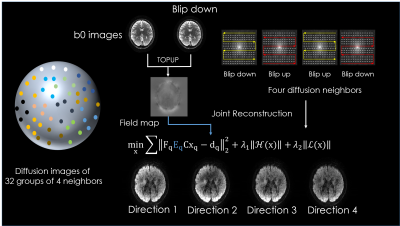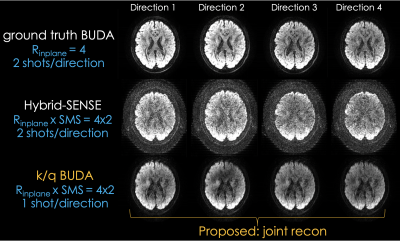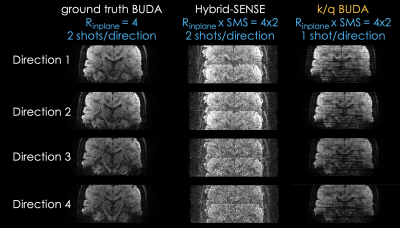3446
Highly accelerated distortion free diffusion imaging using joint k/q-space reconstruction.1Electrical engineering, KAIST, Daejeon, Korea, Republic of, 2Martinos Center, Charlestown, MA, United States, 3MIT, Cambridge, MA, United States, 4Martinos Center, Charlestown, China
Synopsis
We propose k/q Blip-Up and -Down Acquisition (k/q-BUDA) for distortion-free diffusion MRI (dMRI). We acquire different diffusion directions with alternating phase-encoding polarities, and incorporate $$$B_{0}$$$ information in the forward model of our reconstruction. Multiple images on neighboring q-space points are jointly reconstructed using Hankel structured low-rank regularization in k-space. This allows us to exploit similarities across q-space at the parallel imaging level, thus enabling k/q-space joint reconstruction. We select four neighboring q-space samples, providing us with two blip-up and two blip-down phase-encoded shots, who provide complementary $$$B_{0}$$$ encoding to eliminate distortion in the reconstructed volumes.
Introduction
Echo planar imaging (EPI) is the workhorse readout strategy for dMRI. While EPI can provide whole-brain coverage rapidly, it does not lend itself to high-resolution imaging because of severe geometric distortion, resolution loss due to T2 decay, and prolonged echo time (TE) which degrades the SNR. Sensitivity encoding allows for in-plane acceleration (Rinplane) rates of up to 3–4-fold, and can be combined with recent developments in navigator-free multi-shot EPI (msEPI) reconstruction (1–3) to increase Rinplane beyond 6. This, however, comes at the cost of increased acquisition time, as several shots are required to achieve adequate image quality at such high Rinplane factors. Alternatively, two-shots of EPI data can be acquired with opposite phase-encoding polarities, and a field map can be estimated from initial single-shot reconstructions. The two-shots can thus be jointly reconstructed at the parallel imaging level via Hybrid-SENSE (4), where the field map is incorporated in the forward model to eliminate distortion. Herein, we further reduce the encoding burden of distortion-free dMRI by collecting only a single shot per diffusion direction. We jointly reconstruct four neighboring q-space points, which are acquired with alternating phase-encoding polarities. Incorporating B0 map in the forward model eliminates distortion, and the spatially aligned q-space neighbors are jointly reconstructed using Hankel structured low-rank regularization across q-space. We further increase the acquisition efficiency using simultaneous multi-slice (SMS) encoding, thus obtain high-quality, 1.5 mm isotropic, distortion-free dMRI at RinplanexSMS = 4x2. We term our acquisition/reconstruction strategy k/q-BUDA and demonstrate substantial image quality improvement over Hybrid-SENSE reconstruction, which uses twice the number of shots (both blip-up and -down per direction).k/q-BUDA acquisition and joint reconstruction
Fig1. demonstrates q-space sampling scheme where 128 points are distributed on the b=1000 s/mm2 shell. We jointly reconstruct four neighbors at a time, leading to 32 groups of data, so that images with similar diffusion weightings are reconstructed together. In each group, two directions are acquired with blip-up and the other two are acquired with blip-down polarity. We intersperse 9 b=0 data with blip-up and -down polarity in our diffusion table, from which field map information is estimated using FSL topup (5). The field map from the closest b=0 image in time order is used in the joint k/q BUDA reconstruction for b=1000 for diffusion data due to:$$ min_x\sum_q||FqEqCx_q-d_q||_2^2 +λ_1||H(x)||+λ_2||L(x)|| $$
Here are the individual q-space directions, are ESPIRiT coil sensitivities (6), is the field map information, and is the undersampled DFT operator. We shift the k-space sampling pattern of each q-space point to provide complementary k-space information. is a Hankel structured low-rank regularizer across the k-space of the four neighbors, with 8x8 window size. Employing Virtual Coil concept further doubles the number of k-space shots to eight. provides complementary local low-rank regularization in image-space, where 8x8 patches across four neighbors are constrained to be similar. The k- and image-space low-rank regularizers obviate the need for explicit shot-to-shot phase difference estimation, improve image quality and SNR.
Acquisition and Reconstruction Experiments
In vivo data were acquired on a 3T Siemens Skyra system at 1.5 mm isotropic resolution using 32-chan head coil with $$$R_{inplane}$$$=4 acceleration. Each of the 128 b=1000 and 9 b=0 volumes were sampled with blip-up and -down polarities with TE/TR=6500ms/57ms and 168x168x60 matrix size. $$$\Delta$$$ky =2 shift was applied between the blip-up and -down pairs. The total acquisition time was 1 hour. We reconstructed each q-space point separately to obtain “ground truth” data. To this end, we used both the shots per direction in Hankel regularized BUDA reconstruction. To simulate an improved efficiency acquisition, we collapsed two slices that are 30 slices apart with FOV/8 slice shift, and performed Hybrid-SENSE reconstruction on this $$$R_{inplane}$$$xSMS = 4x2 data. Here, each q-space direction had both blip-up and -down shots and no low-rank regularization was applied. Finally, k/q-BUDA reconstruction was applied on the RinplanexSMS = 4x2 data with only a single shot per q-space point. The four neighbors were selected using an iterative clustering algorithm so that the average angle among all pairs in neighboring directions were minimized (less than 22 degrees).Results
Figure 2 shows that the proposed method is capable to resolve SMS 2 and Rinplane = 4.Figure 3 shows coronal image of human brain. The stripe artifact shown in the proposed method is come from slice-by-slice reconstruction. The artifact could be resolved by finding optimal low rank constraint.
Discussion & Conclusion
We proposed k/q-BUDA, an efficient EPI acquisition and joint k-q space reconstruction technique. We employed complementary sampling in k-space by shifting the undersampling pattern in ky direction between the q-space neighbors, and flipped the phase-encoding polarity between these q-space point to encode field inhomogeneity information. Incorporating 2-fold SMS into our acquisition thus allowed for Rtotal=8-fold accelerated, distortion-free dMRI. We demonstrated marked improvements over Hybrid-SENSE which used twice the number of shots, and validated our results against Rtotal=4-fold accelerated BUDA where each q-space point was reconstructed separately using two-shots.Acknowledgements
No acknowledgement found.References
1. Mani M, Jacob M, Kelley D, Magnotta V. Multi-shot sensitivity-encoded diffusion data recovery using structured low-rank matrix completion (MUSSELS). Magn. Reson. Med. 2017;78:494–507 doi: 10.1002/mrm.26382.
2. Bilgic B, Chatnuntawech I, Manhard MK, Tian Q, Liao C, Stephen F. Highly Accelerated Multishot EPI through Synergistic Combination of Machine Learning and Joint Reconstruction. :1–21.
3. Mani M, Jacob M, McKinnon G, et al. SMS MUSSELS: A Navigator-free Reconstruction for Simultaneous MultiSlice Accelerated MultiShot Diffusion Weighted Imaging. 2019:ArXiv: 1901.01893.
4. Zahneisen B, Aksoy M, Maclaren J, Wuerslin C, Bammer R. Extended hybrid-space SENSE for EPI: Off-resonance and eddy current corrected joint interleaved blip-up/down reconstruction. Neuroimage 2017;153:97–108 doi: 10.1016/J.NEUROIMAGE.2017.03.052.
5. Smith SM, Jenkinson M, Woolrich MW, et al. Advances in functional and structural MR image analysis and implementation as FSL. Neuroimage 2004;23:S208–S219 doi: 10.1016/j.neuroimage.2004.07.051.
6. Uecker M, Lai P, Murphy MJ, et al. ESPIRiT-an eigenvalue approach to autocalibrating parallel MRI: Where SENSE meets GRAPPA. Magn. Reson. Med. 2014;71:990–1001 doi: 10.1002/mrm.24751


